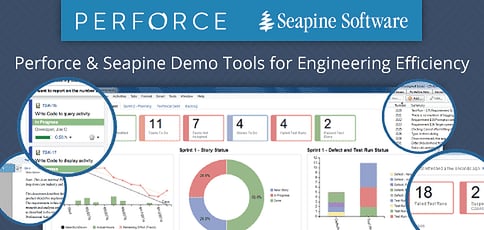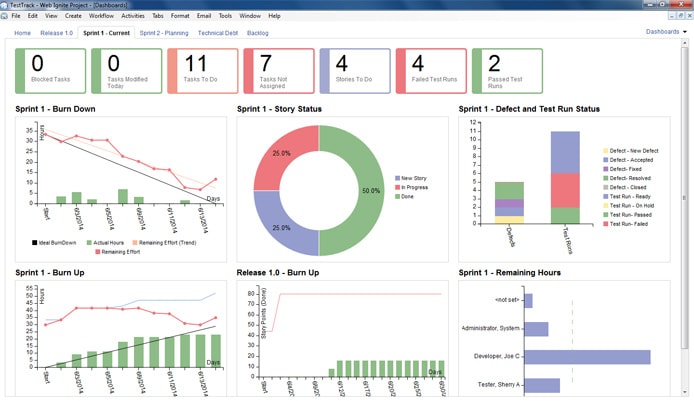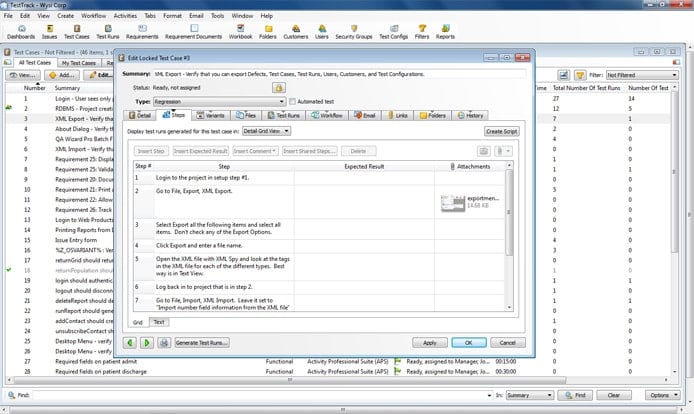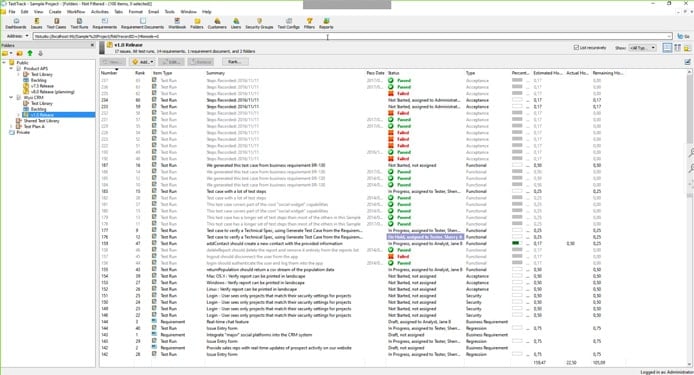
TL; DR: With the late-2016 acquisition of application lifecycle management specialists Seapine Software, version control experts Perforce can now offer a comprehensive suite of tools that help engineering teams across all industries build complex products collaboratively, securely, and efficiently. We got an inside look at how Seapine’s TestTrack system — soon to be rebranded to join Perforce’s Helix products — provides development and IT organizations with the tools, technologies, and best practices to deliver quality products on time and on budget.
German engineering company Softing faced a tough challenge: The company employed two engineering divisions spread across three countries that produced two distinct product lines. The Industrial Automation division wanted to follow a scrum development process to modernize and add flexibility to existing processes, while the company’s Automotive Electronics team needed traceability and a more complex workflow to meet stringent compliance requirements.
Despite drastically different development processes and needs, Softing leadership desired a unified, streamlined, and standardized development toolset — and found one in TestTrack, an application lifecycle management (ALM) platform from Seapine Software that Softing was already using to track issues.
For more than two decades, Seapine Co-Founder and CEO Rick Riccetti has added features to grow the TestTrack suite to encompass the management of project workflows, requirements, testing, and issues.
“That’s been a key strength of our product and what is very attractive to our customer base because they can add functionality as they need it,” Rick said. “It makes the entire portfolio easier to manage, easier to back up, and easier for people to learn another part of the solution as those needs arise.”

Rick Riccetti started Seapine Software near Cincinnati, Ohio, and remains Chief Technology Officer at Perforce.
In addition to TestTrack, several of Seapine’s largest customers use software from Perforce for enterprise-grade version control and source code management. The Minnesota-based company acquired Seapine in November 2016 to provide a rare, comprehensive suite of programs to manage every aspect of product development.
Recognizable brands, such as Apple, Samsung, Honda, General Electric, and Bank of America, in many different industries rely on Seapine and Perforce software to develop performant, safe, and secure consumer-level products, according to Technical Solutions Engineer Nico Krüger.
“You probably use and trust these products,” he said. “They trust us to help them deliver quality work. That’s really what we’re about: helping the best brands in the world deliver some of the best products out there.”
Perforce and Seapine: Comprehensive Tools for Workflow Management
As Seapine and Perforce leadership began discussions about combining the two companies, Rick appreciated the shared focus on accelerating innovation and improving predictability across diverse sectors such as automotive, healthcare, finance, gaming and animation, software and technology, as well as embedded devices.
“What you’re getting as we pull these companies and products together is an incredibly feature-rich and capable application lifecycle management solution with a version control engine that really doesn’t have a competitor today,” he said.

TestTrack will soon rebrand as Helix ALM to join Perforce’s version control system.
Perforce’s suite of Helix version control solutions includes a highly scalable version management and collaboration platform to securely manage changes across all digital content, a Git-based development ecosystem, and a Gerrit-style review platform to connect distributed teams, protect intellectual property, and support rapid release cycles.
Previously, Rick has seen competitors excelling in either the ALM or version control programs — or operating subpar software in both categories.
“I would say that right now, there isn’t really anybody who has the capabilities of Helix and the capabilities of TestTrack all under one portfolio,” he said. “As we work through our roadmap, our goal is to make those look and feel like one product. You’ll see that in the next few weeks, as we work on branding everything together and providing our customers with a more seamless, one-company experience.”
Helix ALM’s Path to Engineering Efficiency
Moving forward as a unified development platform, TestTrack will soon be rebranded as Helix ALM and integrated into the version control system.
Because the engineering teams and the products being created are so complex, Nico said Helix plays a critical role in helping companies deliver results on time, on budget, and with the quality to meet important standards and compliance requirements.
“It’s not as simple as building a website,” Nico said. “It’s usually something much more complex, like things that go into planes, cars, medical devices, and so on. We’ve really worked to engineer a product that is extremely scalable and configurable to do that.”
1. Establishing Agile Development Workflows
Whether your team works in waterfall, agile, kanban, or scrum — or somewhere in the middle, Helix ALM adapts with customizable dashboards and task boards. Users can switch between graphic and list views to find and manage tasks, according to Nico, all with the emphasis of putting relevant information front and center.

Dashboards can be customized on a user-by-user basis to provide the quickest access to information.
“We try to cut down some of the noise to get you directly to what you need to do on a daily basis,” he said. “We try to make it seamless for the user to work the way they want to.”
2. Managing Requirements Through Collaboration
Instead of large teams trying to simultaneously share and edit the same Word document, Helix ALM provides a central hub for everyone to collaborate in parallel. Once a requirements document is imported, Helix ALM organizes the criteria into categories, status, and levels of risk.
Users can track relationships of various requirements, in addition to seeing connected information, which Nico said contributes to one of the most valuable aspects of Helix ALM’s requirements management system — forward and backward impact analysis that flags suspect dependencies.
“Very quickly, I can identify that if we make a change, look at all the stuff we’ll break,” he said. “This type of insight is really important to most of our customers. It gives them the ability to understand the impact of change.”
3. Overseeing Test Cases for QA Visibility
Users can create automated or manual test cases with the abilities to estimate how long each will take and include variants to cover multiple browsers, operating systems, or game consoles. In addition, Helix ALM has built-in algorithms that identify the level of risk each test has to the project’s overall success.

Users can create, edit, and run test cases that link back to the original requirement and other useful data.
Helix ALM’s test case management platform comes with the Defect Scribe add-on that captures and records manual testing steps and automatically includes them in a test case with relevant screenshots and notes.
“I essentially hit a record button, and it captures every single step for me, takes a screenshot, and highlights where I click,” Nico said. “It’s a really efficient way of testing, especially if you’ve got a GUI-based application.”
4. Troubleshooting Issues and Defects With Traceability
Helix ALM helps engineers and administrators investigate failures by streamlining searches of related materials throughout the project.
“Anywhere in the system that error came up, it will bring back results to show if this is a recurring bug or something happened,” Nico said. “We try to make finding data a lot easier, especially if you’ve got large teams.”

Helix ALM offers security and traceability when recording and managing test cases.
Identifying defects in Helix ALM quickly links pertinent information together in an easily shareable way to help reproduce the issue.
“I can see what functional requirements I’ve delivered, but I can also see the test linked to that requirement,” Nico said. “If there was a failure, I can see the defect and its status, and I can actually see it linked to our source code control tools. We can actually show you the line of code affected by the change and trace it all the way back to the top-level requirement.”
5. Generating Reports Automatically With Fine-Grain Control
Providing deeper information than the dashboards, automated reports can help teams make timely, informed decisions with burn down charts, progress reports, and productivity milestones.
“You don’t have to figure out how to do a lot of this stuff,” Nico said. “You basically just select a template. It can be as simple as answering a question of how far you are from release. We’ve got lots of power in our reporting and how you can build up your own reports in the system to get some meaning out of all this data.”
Customer Support and Listening to Users for Updates and New Features
The majority of Perforce customers receive support within an hour, something not many companies with such comprehensive and technical products can match, according to Nico.
“We like to have happy customers, and we listen to our customers,” he said. “With so many people around the world who use our products, there are a lot of great ideas out there. If you listen to them and cut through the noise, often you can see a common theme and pick up on the trends of where things are going.”
Recent customer-driven additions to Helix products include the graphical dashboard and task board interfaces, as well as support for scrum and kanban workflows. Customers can further configure Helix ALM externally through an API or with help from Perforce to boost automation and integrate with other systems.
“We definitely have a long list of things we want to do to the product to enhance capabilities, but we find that a lot of times we can accommodate what companies are looking for just through the configurability of the product,” Rick said. “We really try to keep our finger on the pulse of what’s happening in the world of development methodologies and processes, then go after those types of capabilities and add them on top of the platform we have.”
HostingAdvice.com is a free online resource that offers valuable content and comparison services to users. To keep this resource 100% free, we receive compensation from many of the offers listed on the site. Along with key review factors, this compensation may impact how and where products appear across the site (including, for example, the order in which they appear). HostingAdvice.com does not include the entire universe of available offers. Editorial opinions expressed on the site are strictly our own and are not provided, endorsed, or approved by advertisers.
Our site is committed to publishing independent, accurate content guided by strict editorial guidelines. Before articles and reviews are published on our site, they undergo a thorough review process performed by a team of independent editors and subject-matter experts to ensure the content’s accuracy, timeliness, and impartiality. Our editorial team is separate and independent of our site’s advertisers, and the opinions they express on our site are their own. To read more about our team members and their editorial backgrounds, please visit our site’s About page.

